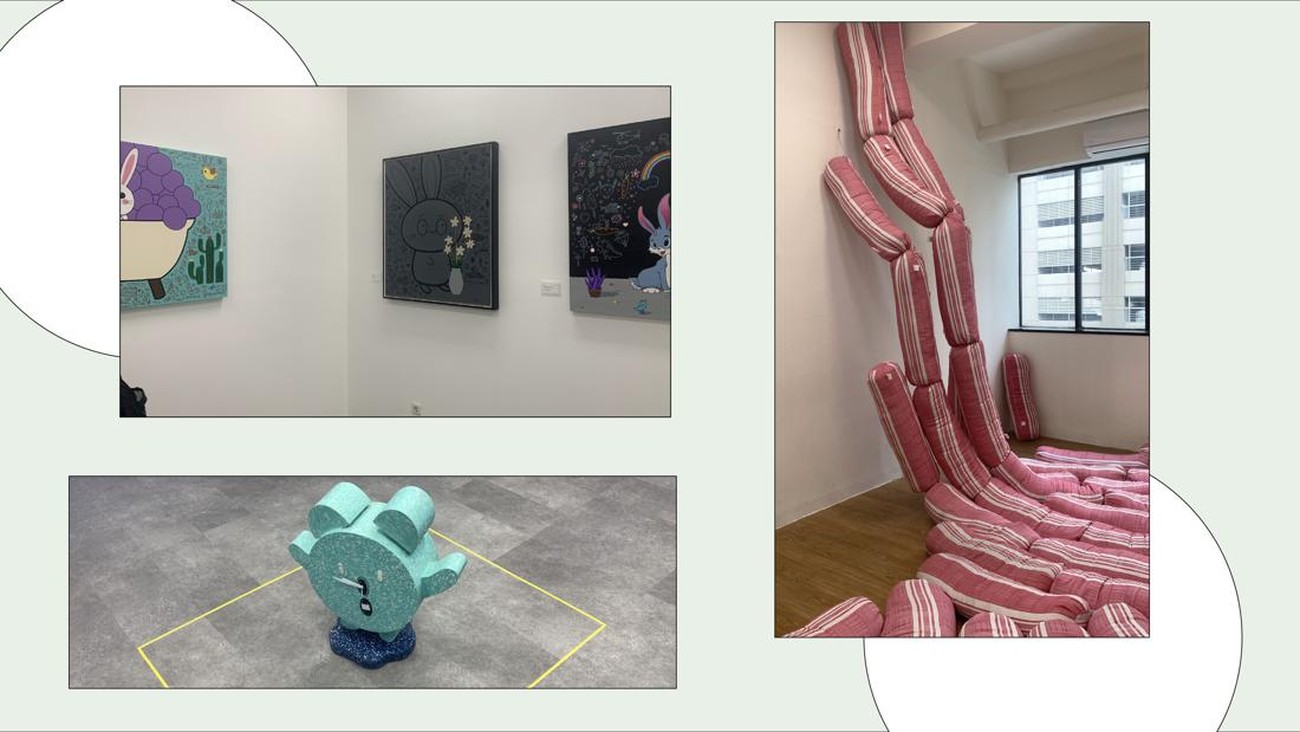Occupying a nondescript aged building in Menteng, Central Jakarta, is Jakarta Art Hub. As the name suggests, the space connects artists, collectors, and art enthusiasts alike—housing numerous galleries that each have their own distinct curation and character. In a gallery tour with Art Jakarta last Thursday (14/9), CXO Media had the opportunity to visit the exhibitions held within the space, whether currently running, almost closed, and yet to open.
On the third floor is Vice and Virtue, a newly-opened gallery that was hosting the last day of Yogyakarta-based artist Erianto's exhibition, Collective Chemistry. The exhibition plays upon the subject of life's interconnectedness and its perpetuity. The artworks displayed possess childlike characteristics, with their colorful palette and playful imagery, yet a closer look revealed Erianto's precise lining and details.
Closer look of Jakarta Art Hub
Thematically, humans' ego informed most of the works in the exhibition, which showcases its bold focal figures at the forefront backdropped by doodles made in a subtler palette. While the "weight" of these subjects are evidently different, its composition conveys the inseparable unity between each of these elements, which symbolize the drive for supremacy as well as desires and emotions, respectively.
Still on the third level, Rachel Gallery hosts an exhibition titled The Blue Room by the artist Gula. The color blue, as the central element of the exhibition, is something that carries personal significance for the artist and his growth. The Blue Room serves as a symbolic haven where the artist's memories and emotions form a visual narrative in the form of artworks both two and three-dimensional.
The only group exhibition currently held in Jakarta Art Hub, Elegi Buih (Elegy of the Foam), can be found in fourth floor's Art Agenda. In the exhibition, curator Stella Wenny recounts the memories of losing her mother and scattering her ashes into the ocean as per her request. By doing so, Stella's late mother said that she could go to any ocean in the world to visit her. Like what her mother said, Stella was never able to look at a vast body of water the same way anymore—she now views it as a place where her beloved mother rests, where the streams bring along memories of those who passed. The ocean and underlying grief serves as a theme that connects all the works displayed.
Some highlights include Olen Riyanto's installation, Live, Die, Double Happiness. The piece contains soft sculptures of bolsters sewn together, with the motif of shuang xi (喜喜)—meaning double happiness—covering them. The word conveys the message to cherish happy memories with loved ones before death eventually comes for everyone. Hung onto the ceiling down to the floor of the gallery, the archway-shaped installation symbolizes the gateway between life and death. The number totals to 39, with one lone bolster laying unsewn in a corner—an intentional decision by the artist to avoid the number 40, since the number 4 is associated with death in Chinese culture. The interactive artwork invites the gallery visitors to interact with the soft sculpture and feel the wobbly insecurity of the many stages of grief. Between the bolsters, visitors can also lay down to let go of the tension of grief with the smell of cotton surrounding them—a scent that is associated with comfort and sleep, which in this context is forever.
While technically not open to the public yet, Iwan Yusuf who was preparing his exhibition, Garis Ombak (Lines of the Waves), in Jagad Gallery graciously let us see an advanced preview. In the midst of installing his works, he explained to us the narrative and process that went through the making of his latest presentation. Better known for his realistic works, Iwan took a spontaneous approach instead for the entirety of his works in Garis Ombak, resulting in impressionistic pieces. He recalled a story of how he almost drowned once, which led to a fear of the water.
Thus, the exhibition serves as a way for him to approach the fear and observe it through another perspective. The paintings, made using charcoal then washed away in the ocean waves, is how Iwan traverses the boundaries of land and sea. As the artist puts it, things that exist in between one another have a distinct beauty to them—namely youth, dawn, or dusk. The medium, charcoal, also serves as a symbol of the earth to Iwan which he "collided" with the element of water.
From the pop, modern, to contemporary, the distinct characteristics of each gallery's presentations made Jakarta Art Hub a vibrant space. With a single visit, one can experience a wide spectrum of arts—making them easily accessible. In line with Art Jakarta's mission, Jakarta Art Hub is a friendly entry point in exploring art without pretensions. From the light-hearted to the profound, have a visit to immerse yourself.
(alm/DIR)


